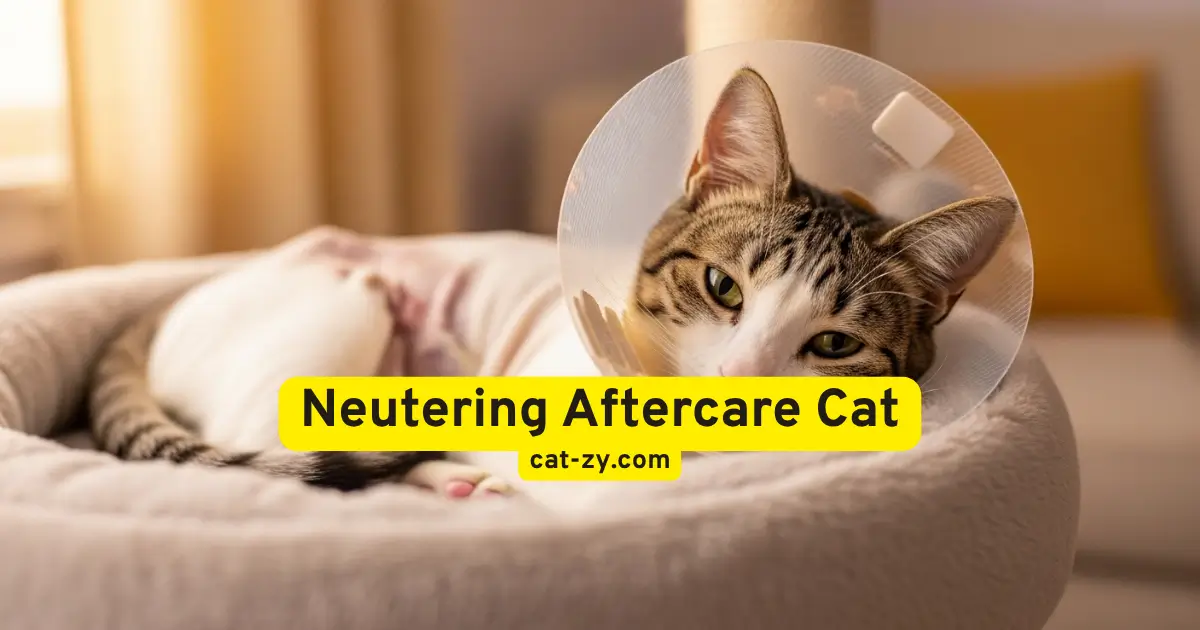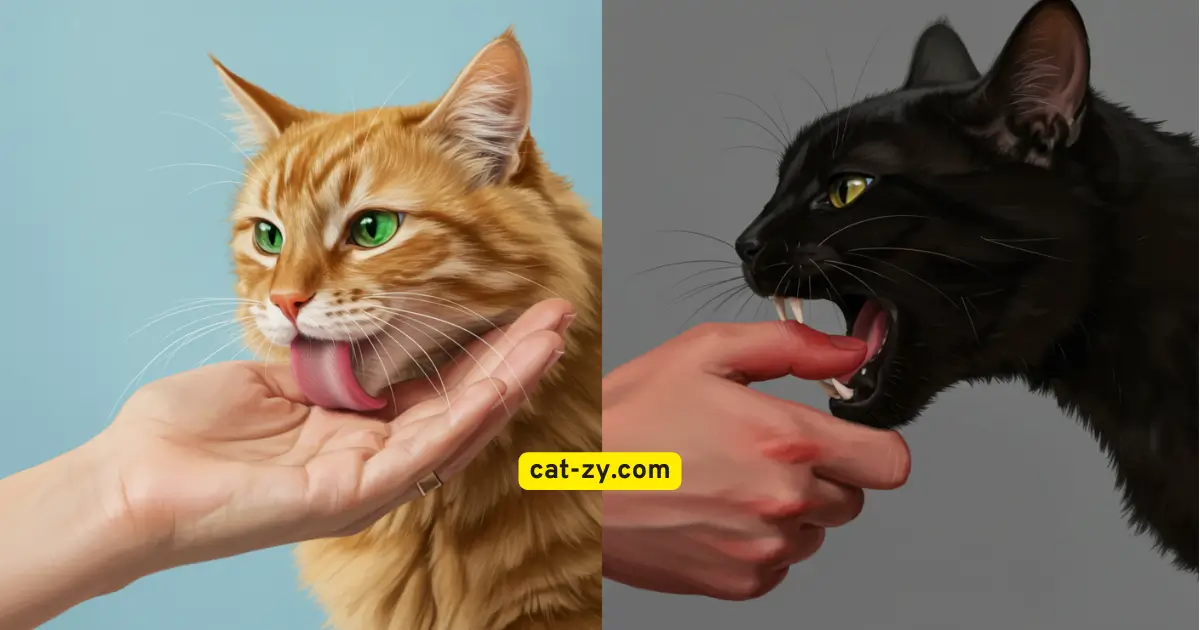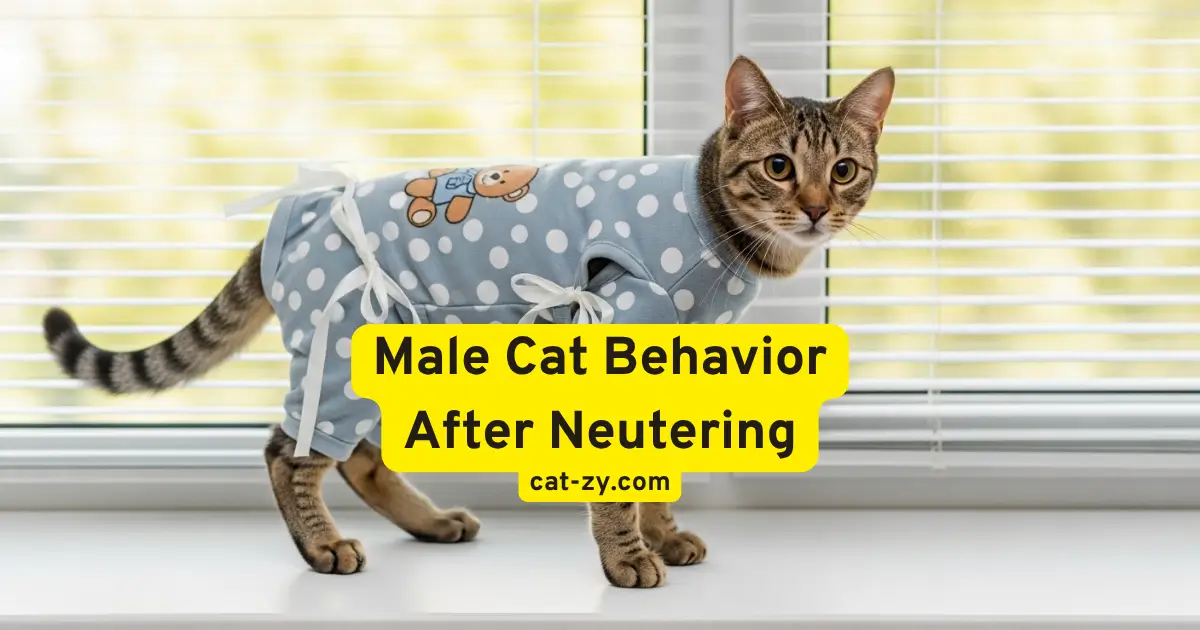Neutering Aftercare Cat Guide: 7 Mistakes to Avoid at All Costs
Neutering aftercare cat recommendations become vital following this crucial surgical intervention. Being a conscientious cat parent, you’ve made the significant decision to have your feline companion spayed or neutered. Now, it’s crucial to ensure your pet heals well. Proper post-surgery care is crucial to prevent complications and aid in your pet’s recovery.
You might be curious about what to expect and how to care for your pet during this time. Spay and neuter recovery tips can help you navigate this, keeping your cat’s health safe.
This guide will show you 7 big mistakes to avoid during your cat’s recovery. Knowing these can help you give your pet the best care. By avoiding these issues, you can greatly lower the chance of problems and help your pet heal fast and safely.
Table of Contents
What to Expect After Your Cat’s Neutering Surgery
Understanding neutering aftercare cat expectations after surgery can make recovery easier. It’s important to understand the changes and care steps needed during this time.
The Physical Impact of Neutering on Your Cat
Neutering surgery can cause immediate physical changes in your cat. Watching for these changes is key to a smooth recovery.
Immediate Post-Surgery Behavior
Your cat may feel tired, groggy, or unsteady after surgery. Monitor your feline closely to avoid potential mishaps or harm.
Normal Recovery Timeline
Cats usually take a few days to a week to fully recover from neutering surgery. You might see swelling, redness, or discharge at the surgery site. Monitoring these symptoms is vital to catch any complications early.
Why Proper Recovery Matters for Long-term Health
Proper neutering aftercare cat recovery extends beyond the immediate post-surgery period. It greatly affects your cat’s long-term health. Complications during recovery can cause infections, longer healing times, or serious health issues. By following your vet’s instructions and creating a safe, comfortable space, you can help your cat recover fully and stay healthy.
Proper aftercare, like limiting activity and watching the incision site, is critical. It helps prevent complications and supports your cat’s overall health. As you guide your cat through recovery, remember that patience and attention to detail are essential for effective healing.
Mistake #1: Ignoring Post-Operative Instructions from Your Veterinarian
Ignoring your vet’s post-operative instructions is a big mistake for cat owners. These instructions are made just for your cat. They help your cat recover safely and smoothly.
Common Instructions You Shouldn’t Overlook
Your vet will give you specific instructions. These might include when to give medication, how much activity is okay, and watching the incision site. It’s key to follow these to avoid problems.
Medication Schedules and Dosages
It’s important to give your cat the right medicine at the right time. This helps with pain and keeps infections away. Always stick to the medication schedule and dosage your vet tells you. If you’re not sure, ask for help.
Activity Restrictions and Duration
Keeping your cat calm and quiet is important while they heal. Your vet will tell you how long to keep them quiet. Usually, cats should avoid jumping or running for a bit.
Creating a Checklist for Your Cat’s Recovery
Make a checklist from your vet’s instructions to help you remember. It should include giving medicine, watching the incision, and keeping them calm. This checklist helps you care for your cat well during recovery.
Taking good care of your cat after neutering means following your vet’s instructions closely. This helps your cat heal without problems.
Mistake #2: Allowing Too Much Activity During Neutering Aftercare
Many cat owners make critical neutering aftercare cats. They let their pets move too much. This can hurt your cat’s healing process.
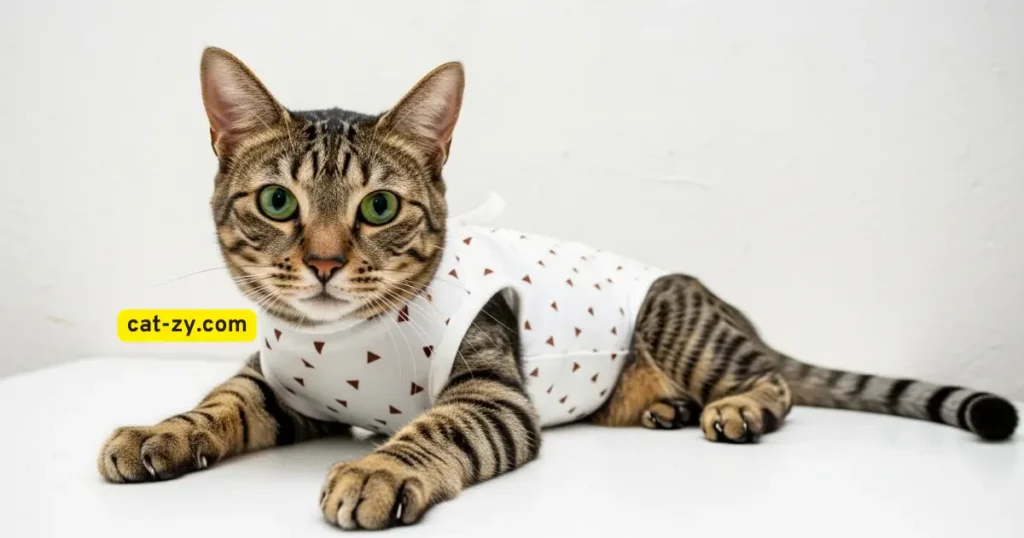
The Risks of Premature Exercise and Play
Too much activity can stress your cat’s body, hurting the incision site. This might cause swelling, bleeding, or infection. These issues can make recovery take longer.
Internal Healing Timelines
Healing inside takes time. Even if the outside looks fine, the inside tissues are fragile. It usually takes 7-10 days for the first healing stage. But, this can change based on your cat and the surgery.
Potential Complications from Overexertion
Too much activity can cause serious problems. These include infection, herniation, or the incision opening. Watch for signs like redness, swelling, or discharge. If you see these, call your vet right away.
Effective Ways to Limit Your Cat’s Movement
It’s key to keep your cat from moving too much. Give them a cozy, safe place to rest.
Safe Confinement Options
Put your cat in a quiet, enclosed area. A bathroom or a big crate works well. This restricts excessive movement while promoting proper healing.
Enrichment Activities for Recovering Cats
Even when they can’t move much, you can keep your cat’s mind active. Use puzzle toys with treats or play games that don’t need much movement.
Mistake #3: Improper Monitoring of the Incision Site
Monitoring the incision site is key in post-neuter care for cats. After neutering, watch the incision closely. This helps it heal right and spot problems early.
What a Healthy Healing Incision Looks Like
A good incision site is clean and dry. The edges should be close together. A bit of swelling or redness is normal but should lessen as healing progresses.
Day-by-Day Healing Progression
Healing starts with a red or swollen site. This should get better by the third or fourth day. By the first week, swelling should lessen, and redness should fade. If swelling or redness gets worse, it’s a sign of trouble.
When to Take Photos for a Vet Consultation
Capture detailed images of your feline’s surgical area each day. Start on the surgery day. These photos help your vet see how your cat is healing. They can spot issues early.
Warning Signs That Require Immediate Veterinary Attention
Some swelling or redness is normal. But some signs mean you need to see a vet fast. Recognizing these indicators ensures your feline’s safety throughout the healing process.
Infection Indicators
Look out for increased redness, swelling, or discharge. A bad smell or your cat showing pain are also signs. These could mean an infection.
Dehiscence and Other Serious Complications
Dehiscence, where the incision opens, is serious. Also, watch for a lot of bleeding, swelling, or if your cat keeps licking or chewing at the site. If you see these, call your vet fast.
Watching your cat’s incision site closely and knowing the signs of trouble helps ensure a smooth recovery. Good neutering aftercare cat practices are vital for your cat’s health and happiness.
Essential Neutering Aftercare Cat Practices for a Smooth Recovery
Effective neutering aftercare cat practices require the right recovery environment. A good recovery spot can lower risks and get your cat back to normal fast.
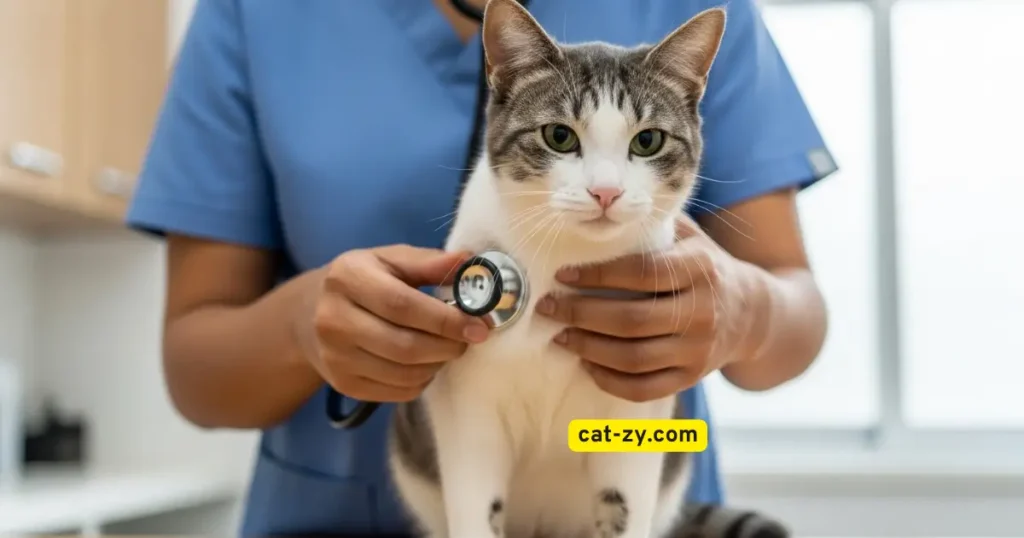
Creating a Comfortable Recovery Space
It’s important to make a quiet spot for your cat to rest. This area should be away from household noise. It should be peaceful, helping your cat relax and rest.
Temperature and Bedding Considerations
Keeping the recovery area at a comfy temperature is vital. It should not be too hot or cold. Offer a soft, warm bed or blanket for your cat. A heated cat bed is okay, but watch it closely.
Stress Reduction Techniques
Lowering stress is key to a smooth recovery. Stick to your cat’s usual routine. Give them familiar comforts like favorite toys or blankets. Pheromone diffusers can also help calm them.
Nutrition and Hydration Considerations Post-Surgery
Nutrition and hydration are important for recovery. Make sure your cat always has fresh water. Follow your vet’s advice on food and when to eat it.
Appetite Changes and Solutions
Cats often eat less after surgery. Try giving them palatable, easily digestible food. If they don’t want to eat in a day or two, talk to your vet.
Special Dietary Needs During Recovery
Some cats need special food while they recover. Your vet might suggest a certain diet. Follow their recommendations to support optimal feline recovery.
By following these aftercare tips, you can make your cat’s recovery better. This can help avoid problems and get them back to their happy self quickly.
Mistake #4: Inadequate Pain Management During Recovery
After your cat’s neutering surgery, it’s key to manage their pain well. This helps them feel better and heal faster. Without good pain control, your cat might feel stressed, which can slow down their recovery.
Recognizing Signs of Pain in Your Cat
Cats often hide when they’re in pain. It can be hard to tell if they’re uncomfortable. But, there are signs you can look for to see if your cat is in pain.
Subtle Pain Indicators Often Missed
Look for changes in appetite, posture, and activity levels. Your cat might also act differently, like being more irritable or withdrawn. Spotting these signs early can help you catch pain quickly.
Using Pain Scales for Assessment
Vets use pain scales to check how much pain animals are in. Knowing about these scales can help you talk better with your vet. Even if you can’t use the scale, understanding what your vet looks for can help you notice your cat’s behavior more.
Safe Pain Management Options and When to Use Them
Managing your cat’s pain safely means knowing the right options and when to use them. Your vet will create a pain plan just for your cat.
Prescribed Medications vs. OTC Options
Always follow your vet’s advice on pain meds. Prescribed medications are chosen just for your cat’s needs. Using OTC pain relievers without your vet’s okay can be risky. Some OTC meds are toxic to cats, so always check with your vet first.
When to Contact Your Vet About Pain Control
If you see signs of pain or worry about your cat’s comfort, call your vet. They can help adjust the pain plan or deal with any issues. Acting quickly can help your cat avoid more pain and recover better.
Mistake #5: Using the Wrong Type of Litter During Recovery
After your cat’s neutering surgery, the litter in their litter box can either aid or hinder their healing. Proper litter choice is a key part of caring for your cat post-neuter, as it affects their recovery.
Why Traditional Litter Can Cause Complications
Traditional cat litters can be risky for your cat’s recovery. The main concerns are dust and particles, and the risk of infection.
Dust and Particle Concerns
Dusty litter can irritate your cat’s eyes and the surgical site. Choosing a low-dust or dust-free litter can greatly reduce these risks, making recovery easier.
Infection Risks from Certain Litters
Certain litter types, including clay-based or clumping varieties, may adhere to the surgical wound and trigger infections. Maintaining litter box hygiene is crucial, along with selecting the appropriate litter material.
Recommended Litter Alternatives for Healing Cats
For a cat recovering from neutering, it’s best to use a gentle litter. Paper-derived litter or recycled paper alternatives are frequently suggested due to their minimal dust content and reduced irritation potential.
Paper-Based and Other Safe Options
Paper-derived litter provides excellent absorption while offering comfortable footing for your feline. Other safe options include natural, non-toxic materials.
Transitioning Back to Regular Litter
Once your cat has fully recovered, you can switch back to their regular litter. Monitor your feline’s wellbeing and make necessary modifications to guarantee a seamless changeover.
Mistake #6: Neglecting Emotional Support and Behavioral Changes
During your feline’s neutering recovery period, addressing their psychological requirements becomes paramount. This surgery can change how they act and feel.
Common Behavioral Changes to Expect After Neutering
Your cat might change in many ways after neutering. These changes can be short-term or last a long time, affecting their personality and habits.
Short-term Personality Shifts
At first, your cat might feel tired or restless. They might want to be closer or seem more alone. Give them a cozy place to rest and adjust.
Long-term Behavioral Benefits
Neutering can help stop bad behaviors like spraying or fighting. Your cat might become more loving and less likely to wander off. This makes them better friends.
How to Comfort Your Cat Without Disrupting Recovery
It’s important to comfort your cat gently during recovery. You want to show love without making them move too much.
Safe Bonding Activities
Do quiet, gentle things with your cat, like talking softly or petting them gently. But don’t play too hard, or it might hurt them.
Creating Security During Recovery
Make sure your cat has a quiet, comfy spot to rest. A warm blanket or something with your scent can help them feel safe. Keeping their space calm helps them heal faster.
Mistake #7: Removing the E-Collar Too Early
Removing the E-collar too soon is a big mistake for cat owners after neutering. The E-collar keeps your cat from licking or scratching the surgery area. It’s important to keep it on for the full time to avoid complications and help your cat heal.
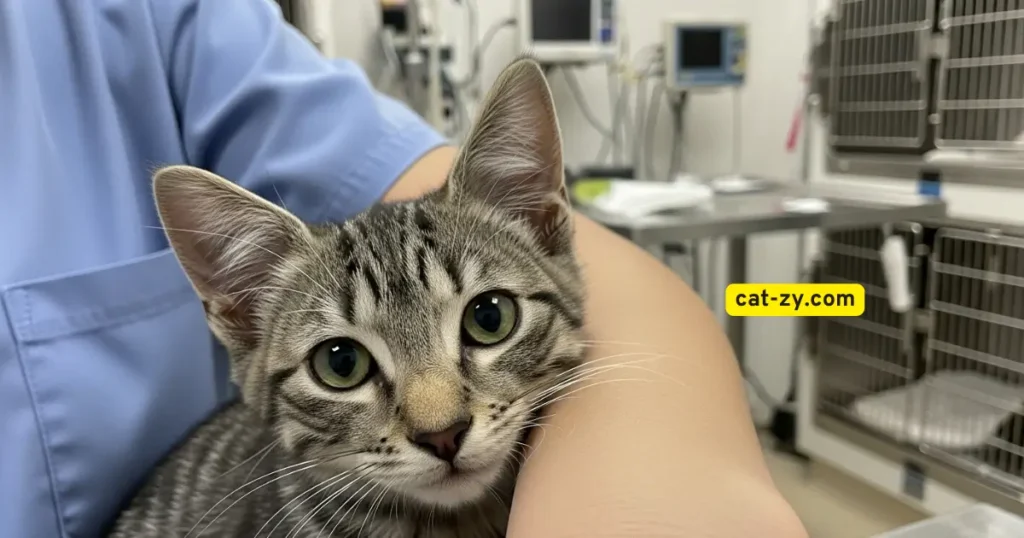
Why the E-Collar Is Critical for Recovery
The E-collar is key to your cat’s healing. It stops them from getting to the surgery area, which helps prevent infection and aids in healing.
Self-Trauma Prevention
The protective cone prevents felines from grooming or nibbling at their surgical location. Such behavior may result in inflammation, bacterial contamination, or wound dehiscence. It’s vital to stop self-trauma to avoid problems and help your cat’s wound heal properly.
Proper E-Collar Fit and Adjustment
The E-collar must fit right to work well. It should be snug but not too tight, so your cat can move easily. Check the fit often and adjust it as needed to keep your cat comfortable and safe.
E-Collar Alternatives and Proper Usage Techniques
Some cat owners might like other options instead of traditional E-collars. These include soft collars and recovery suits that are comfy and protect the surgical area.
Soft Collars and Recovery Suits
Soft collars and recovery suits are good alternatives. They’re softer and can be more comfy for cats. Soft collars are less stiff, and recovery suits cover more area for extra protection.
Safe Supervised Breaks from the Collar
If your vet says it’s okay to take off the E-collar, do it carefully. Watch your cat closely to make sure they don’t lick or scratch the surgery area during these breaks. Through this approach, your feline receives collar relief while maintaining safety.
Summary: Guaranteeing Optimal Healing Following Your Cat’s Neutering Surgery
Thorough neutering aftercare cat protocols are fundamental for seamless healing. Avoiding common mistakes can help your cat heal well. This guide helps you do just that.
Good aftercare means watching the incision, managing pain, and keeping your cat calm. A comfy place to rest and a healthy diet are also important.
Being careful and proactive in aftercare helps your cat recover better. For more tips, talk to your vet. They can help you give your cat the best care.
FAQ
What should I expect immediately after my cat’s neutering surgery?
After the surgery, your cat will likely be sleepy and a bit confused. They might also feel some pain, swelling, or bruising. Maintain careful observation while adhering to your veterinarian’s guidance.
How long does it take for my cat to recover from neutering surgery?
Recovery time for cats can be a few days to two weeks. Most cats can get back to normal in 7-10 days. Consistently implement your veterinarian’s recommendations regarding care protocols and activity levels.
What methods can enhance my feline’s comfort throughout the healing phase?
Give your cat a quiet, warm spot to rest. Follow your vet’s advice on pain management. Also, watch their incision for any issues.
What are the signs of complications after neutering surgery that I should watch out for?
Watch for excessive hemorrhaging, inflammation, or fluid secretion. Also, watch for increased pain, tiredness, loss of appetite, or vomiting. If you see these signs, call your vet right away.
Can I bathe my cat after neutering surgery?
It’s best to wait until the incision is fully healed, usually 10-14 days. Check with your vet for specific advice, as needs can vary.
How do I care for my cat’s incision site after neutering surgery?
Keep the area clean and dry. Stop your cat from licking or scratching itself. Follow your vet’s instructions for monitoring and reporting any issues.
What type of litter should I use for my cat after neutering surgery?
Use a low-dust, non-clumping litter like paper-based. Avoid clay or clumping litters to prevent irritation and infection.
How can I limit my cat’s activity after neutering surgery?
Provide a safe, quiet space for rest. Restrict access to stairs and jumping areas. Gentle play or puzzle toys can keep them calm and entertained.
When should I remove the E-collar from my cat after neutering surgery?
Follow your vet’s advice on removing the E-collar. It’s usually 7-10 days to prevent self-trauma and ensure healing. Removing it too soon can cause problems.

